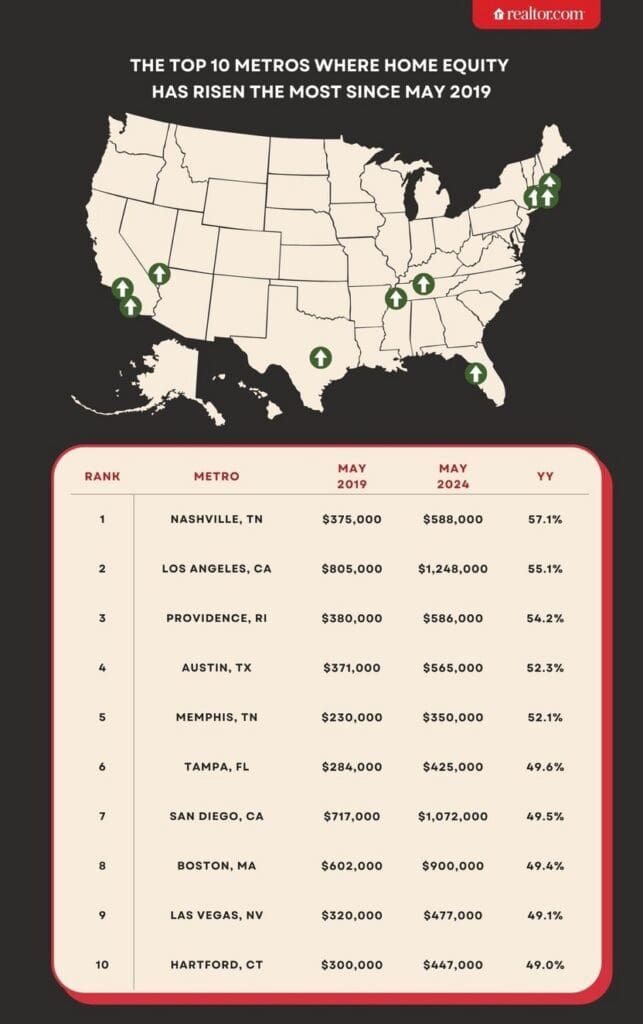Bought a Home Pre-Pandemic? Here’s How Much It’s Worth Now
Here’s where home prices have risen the most in the past five years—and why some sellers might not want to cash out.
Homeowners across America who bought before the COVID-19 pandemic stand to make a “tidy profit” if they were to sell today, according to the latest monthly housing report from Realtor.com®.
Just how much financial gain can an owner reap? Although the exact amount will vary by location, the typical listed home price grew by an astounding 37.5% overall, from May 2019 to May 2024.
“Homeowners have seen extraordinary gains in home equity over the past five years,” says Realtor.com senior economist Ralph McLaughlin.
Here’s where home prices rose the most—and why some sellers might want to wait before cashing out.
Why Home Equity Is Up
The pandemic sent the real estate market into overdrive, pushing median home prices to a record high of $449,000 in June 2022.
The housing market has cooled significantly since the frenzied days of the pandemic, largely due to mortgage rates doubling over the past few years. (They’re now hovering near 7%.) That spike forced potential buyers to the sidelines to wait for more affordable terms on their home loans.
But what hasn’t cooled is home prices: The national median list price reached $442,500 in May, up from $441,000 at this time last year, indicating that home prices have barely budged.
Why are prices still sky-high? Blame the ongoing lack of homes for sale nationwide.
“While inventory this May is much improved compared with the previous three years, it is still down 34.2% compared with typical 2017 to 2019 levels,” says Realtor.com economic data manager Sabrina Speianu.
Where Home Equity Rose the Most
A total of five metros saw home prices rise more than 50% over the past five years.
Nashville, TN, can claim the top spot where prices have risen the most, jumping 57.1% since 2019. Back then, the median home price was $375,000. Now, buyers must plunk down $588,000 for a typical home.
The second-biggest boom in home prices occurred in Los Angeles, where median list prices rose from $805,000 to $1,248,000, an increase of 55.1%. The East Coast claimed the third spot, with Providence, MA, seeing prices soar 54.2%, going from $380,000 to $586,000 since 2019.
n the pandemic boomtown of Austin, TX, median home prices skyrocketed from $371,000 to $565,000, a 52.3% rise. Finally, Memphis, TN, saw prices edge up by 52.1%, from $230,000 to $350,000.
“Meanwhile, all 50 of the largest metropolitan areas have seen sizable price growth compared with homes listed before the pandemic,” explains Speianu. “Compared with May 2019, the price-per-square-foot growth rate in the 50 largest metros ranged from 23.2% to 84.7%.”

Sellers Should Think Carefully Before Cashing Out
Buying a home is one of the best ways to build wealth, yet selling one comes with a few potential financial pitfalls. The biggest one can be capital gains tax.
In a nutshell, if you sell a home for more than what you paid for it, you have to pay tax on the profit above a certain amount.
“All of those equity gains can come at a cost for sellers,” says McLaughlin. “It’s important for them to remember that they can only exclude up to $250,000 of equity gain from their income, or up to $500,000 if they file a joint return with their spouse.”
Any profit beyond these deductions is taxable at varying rates depending on your income.
“The kicker is that the IRS has a five-year test period during which the taxpayer must have resided in their home full time for at least two of the past five years in order to take the exclusion,” explains McLaughlin. “So seller beware.”
Another reason sellers might hang on to their homes for now? To avoid becoming buyers facing hefty home prices.
How Homeowners Can Use Home Equity
Instead of selling as a means to tap into cash, homeowners can take out a home equity line of credit, or HELOC. A HELOC allows a homeowner to borrow money using the equity in the home as collateral.
The total amount you can borrow depends on how much equity you have in your home. A lender will usually allow you to borrow approximately 75%–85% of the home’s appraised value, minus what you still owe on it.
“However, they should think about their home equity like they think about cash in their bank account: conservatively,” says McLaughlin.
A homeowner sitting on a massive amount of home equity might be tempted to use the cash to treat themselves to a new car or a lavish vacation.
“It is more prudent to use cash-out proceeds to make additional investments,” cautions McLaughlin. “When it comes to using home equity, homeowners should think less about buying cybertrucks and partying in Cancun and more about tackling deferred home maintenance, buying an asset, or investing in a loved one’s education.”
What the Price Growth Means for Buyers
While sellers celebrate their bump in equity, potential buyers are likely wishing prices would fall quickly.
“For buyers, this increase has certainly cut into affordability between higher interest rates and home prices,” says Cara Ameer, a bicoastal agent with Coldwell Banker licensed in California and Florida. “In many cases, buyers have had to reduce the price they can comfortably afford by a significant amount.”
An adjustment in a buyer’s ability to afford a home might also mean a pivot in the type of home they can purchase.
“It may mean the difference between buying a single-family home versus a townhome or condominium,” adds Ameer.
However, there is good news for buyers on a budget.
“In May, as in the previous three months, the growth in homes particularly priced in the $200,000 to $350,000 range outpaced all other price categories, as home inventory in this range grew by 46.6% compared with last year,” says Speianu.
Source: Realtor.com®